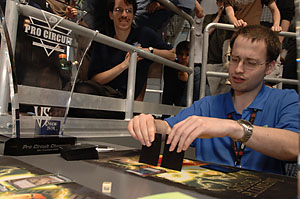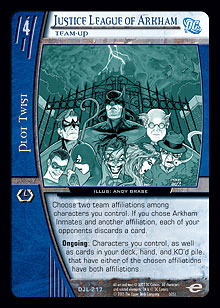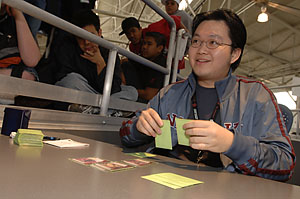
I am writing this article right after my return from Pro Circuit San Francisco. Since PC: San Francisco was also the Pro Circuit debut of Infinite Crisis, it presented a great opportunity to see the newest Vs. set in action. For those of you who didn’t follow the PC, you can see the Metagame coverage here.
The Most Influential Set Since Origins
 When R&D started designing and developing Infinite Crisis, we wanted to create a set that would shake up the tournament metagame. It looks like we succeeded. Infinite Crisis was found all over the place in the new and exciting Silver Age. The tournament was won by a Checkmate toolbox deck piloted by Ian Vincent. This deck focused on the power of Ahmed Samsarra to fetch any of a number of useful locations to answer any threat. Many other decks trotted out Kings as Ahmed and Maxwell Lord led their Checkmate teams into battle. The somewhat risky King mechanic also created some amusing stories from the weekend. Many players lost by having their Kings KO’d to Deadshot, Floyd Lawton or Fatality, but one of the Pro Circuit Champion’s feature matches ended even more abruptly when he recruited a second Ahmed Samsarra, thereby KO’ing his first one and losing the game immediately. Ian came back from that loss to win the entire event.
When R&D started designing and developing Infinite Crisis, we wanted to create a set that would shake up the tournament metagame. It looks like we succeeded. Infinite Crisis was found all over the place in the new and exciting Silver Age. The tournament was won by a Checkmate toolbox deck piloted by Ian Vincent. This deck focused on the power of Ahmed Samsarra to fetch any of a number of useful locations to answer any threat. Many other decks trotted out Kings as Ahmed and Maxwell Lord led their Checkmate teams into battle. The somewhat risky King mechanic also created some amusing stories from the weekend. Many players lost by having their Kings KO’d to Deadshot, Floyd Lawton or Fatality, but one of the Pro Circuit Champion’s feature matches ended even more abruptly when he recruited a second Ahmed Samsarra, thereby KO’ing his first one and losing the game immediately. Ian came back from that loss to win the entire event.
Checkmate and Villains United both made a big splash at this tournament. In addition, the Fate Artifacts found their way into many different decks, each trying to create a giant character early in the game. Other individual power cards like Mr. Mxyzptlk, Troublesome Trickster found a home in decks looking to smooth out their draws or find some help against the Justice League of Arkham discard decks.
Unexpected Developments
Another of R&D’s objectives for Infinite Crisis was to create an open-ended metagame where players could truly explore their own archetypes and not be forced into linear “pre-built” ones. Again, it seems we succeeded . . . almost too well. San Francisco had the most diverse metagame in Pro Circuit history, with almost every major team represented. Some decks that appeared were completely unexpected and took advantage of rules loopholes that even some members of R&D (myself included) were unaware of.
The most interesting of these was the following list, played and created by Aaron Weil and John-Michael Erlendon:
Characters
2 Artie, Arthur Maddicks
4 Fiddler, Isaac Bowin
4 Deadshot, Dead Aim
3 Tar Baby, Adhesive Ally
4 Healer, Life Giver
4 Parademon, Apokoliptian Ally
4 Storm, Leader of the Morlocks
1 Spider-Man, Peter Parker
3 Marrow, Gene Nation
1 White Tiger, Hector Ayala
4 Callisto, Morlock Queen
3 Scandal, Savage Spawn
1 Zazzala ◊ Queen Bee, Mistress of the Hive
Plot Twists
4 Enemy of My Enemy
4 Pleasant Distraction
4 Morlock Justice
4 Help Wanted, Team-Up
2 Millennium
Locations
4 House of Secrets
This deck abused a loop in the current wording of Parademon that allows him to be revealed any number of times (say, a million). When a 4-drop becomes stunned (preferably by evasion), Parademon could come into play adjacent to Callisto. Between the resolution of each trigger, Callisto could return Parademon to hand, allowing it to be replayed again (in the meantime distributing a million +1 ATK / +1 DEF counters). This brutal combo didn’t dominate because of the speed of this format, but it was certainly against our intent for the functionality of Parademon, and we errata’d Parademon to prevent this kind of abuse in the future. Still, it was kind of neat to see it in action.
Another card that functioned differently than we expected was Threat Neutralized. Because of an obscure rule that costs cannot be replaced, Threat Neutralized didn’t remove from the game any characters KO’d to pay a cost. Thus, many players hoping to use Threat Neutralized to limit the effectiveness of cards like Hope and Poison Ivy, Deadly Rose were disappointed. We analyzed this rule upon return from the Pro Circuit and found that other potentially dangerous combos involving Attend or Die, Devil’s Due, and any character that could be played without paying its recruit cost could be enabled because of it. This time, a change to the rules was in order to make this card play the way we intended.
To Ban or Not to Ban
 As I have stated in the past, Infinite Crisis was intended to test the limits of what we can do in Vs. System. There were many powerful effects that enabled archetypes we could not foresee. This led to a lot of exciting new decks and some decks that we were less than happy about. Specifically, the most played deck at PC: San Francisco was a Justice League of Arkham–based discard deck. By searching for and reusing the powerful Team-Up, this deck could empty an opponent’s hand on turn 4, leaving that person without even a resource to play! Many of the top players ran this deck, and many others ran cards like Sage and Phantom Zone with the hope of defeating it. Though the deck did not completely dominate the tournament, the play experience of missing resource drops due to discard effects is certainly not one we want to see over the long term.
As I have stated in the past, Infinite Crisis was intended to test the limits of what we can do in Vs. System. There were many powerful effects that enabled archetypes we could not foresee. This led to a lot of exciting new decks and some decks that we were less than happy about. Specifically, the most played deck at PC: San Francisco was a Justice League of Arkham–based discard deck. By searching for and reusing the powerful Team-Up, this deck could empty an opponent’s hand on turn 4, leaving that person without even a resource to play! Many of the top players ran this deck, and many others ran cards like Sage and Phantom Zone with the hope of defeating it. Though the deck did not completely dominate the tournament, the play experience of missing resource drops due to discard effects is certainly not one we want to see over the long term.
From reading the forums, it seems that most people agree with us that Justice League of Arkham had to be dealt with, though there seems to be a lot more debate about the other card we were forced to ban, Antarctic Research Base. R&D’s position on this was covered admirably by Dave Humpherys in his article, which I highly recommend reading if you are interested in this subject. I would only add that banning cards is without a doubt the worst part of this job. We know that players are attached to their cards and we know that it sucks to have cards you own get banned. We are doing our best to make this the best, most exciting game out there. Our development team is without question one of, if not the, best in the industry, but we are human and sometimes we make mistakes. The important thing is that we don’t let those mistakes ruin the game by letting them run unchecked. For those of you who miss the honest uses of Antarctic Research Base, be patient! Many of us are very attached to ARB too, and you can expect to see a new, fixed version in the future.
I Left My Heart in San Francisco
 It’s hard to see the Pro Circuit as anything but a huge success. Even with a few rules quirks and the discard deck, players had a great time at the Pro Circuit and it led to one of our strongest Top 8s yet. In particular, watching Vidi Wijaya make his fourth Top 8 appearance was truly incredible. He is quickly solidifying his position as the game’s top player. We will find out at PC: Indy if he can continue his amazing consistency or if someone else can rise to contest the title of Best Player in the World.
It’s hard to see the Pro Circuit as anything but a huge success. Even with a few rules quirks and the discard deck, players had a great time at the Pro Circuit and it led to one of our strongest Top 8s yet. In particular, watching Vidi Wijaya make his fourth Top 8 appearance was truly incredible. He is quickly solidifying his position as the game’s top player. We will find out at PC: Indy if he can continue his amazing consistency or if someone else can rise to contest the title of Best Player in the World.
R&D was out in force at this Pro Circuit, sending over half a dozen members to help judge the event, interact with players, and watch all the fun. Nothing is more rewarding as a game designer than seeing players playing with the cards you made, and for me, San Francisco was a particular treat because of the debut of Crisis. We all learned a lot from watching and talking to the players at San Francisco, and R&D will take what it has learned to make this game even better than it already is.
Player feedback is one of the most important aspects of working on a trading card game, and just because you didn’t make it out to the PC doesn’t mean we don’t want to hear from you. We monitor the forums on popular Vs. fan sites, and as always, I encourage you to email me at Justin_Gary@upperdeck.com with your opinions on the Pro Circuit, the newest set, or Vs. System in general. Together, we will continue to make this great game even better. See you all next week.